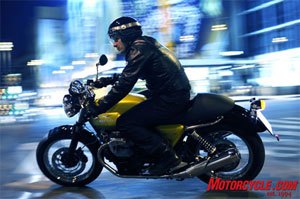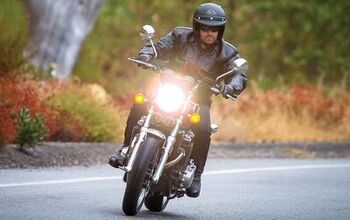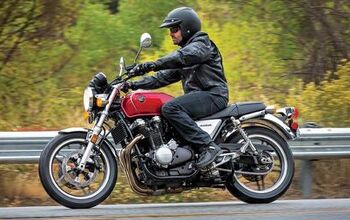The SEE System: Increasing Your Visibility
If there were ever a need to be proactive, assertive and in control, it is while riding a motorcycle. Motorcyclists and scooter riders are arguably the most vulnerable motor vehicle operators on the road.
According to the National Highway Traffic Safety Administration (NHTSA), when compared to operators of a passenger vehicle, motorcyclists on American highways in 2006 had a 35 times greater chance of being killed per vehicle mile traveled.
Studies show that because motorcycles are much smaller, they may not be “seen” or fully, consciously registered in the minds of other motorists.
| Allstate Insurance On Rider Safety |
Our friends at Allstate Motorcycle Insurance know a thing or two about motorcycle safety. In addition to Motorcycle.com's safety series, Allstate Motorcycle Insurance has its own valuable safety information to share. * Motorcycle Awareness: Safety Tips from Allstate Motorcycle Insurance |
And in today’s increasingly dense traffic, even when motorists do see riders, some may not demonstrate sufficient respect for them for one reason or another. It may be conscious or unconscious on their part, but either way, your life and welfare could depend on it.
Because of these and other realities, the Motorcycle Safety Foundation (MSF) has evolved a system for managing the many risks riders face. The system is based on the premise that you are the one most responsible for your own safety. As a rider, it is your job to look out for yourself, and not fully trust others any more than you have to. No one has your best interests at heart more than you.
The word “SEE” is an acronym for a learned process of seeing, assessing and responding to traffic, the road, and more. It stands for “Search, Evaluate, and Execute.”
Search
Whether riding an interstate highway, suburban street or backcountry road, your goal is to visually recognize anything that could affect your control and safety. The idea is to consciously recognize not only what’s right in front of you, but to also look 12 seconds ahead, and be aware of what’s 360 degrees around you as well.
You do this partly by scanning your mirrors, looking side to side, and doing “head checks” as needed to monitor blind spots, or when changing lanes. Some mirrors are convex, and do not accurately portray distances. Looking directly where you are going or at what is coming your way is safest.
The categories of things you continually look for are:
1. Traffic control devices and markings
2. Road characteristics and surface conditions,
3. Other roadway users.
Evaluate
You need to effectively process the visual information you are continually taking in. The MSF recommends, “To get the best results, predict the worst possible outcome." This does not mean you ought to be paranoid, but it does mean anticipate and be ready.
For example, if you are going through a four-way stop, and a car in the road perpendicular to you is about to cross your path, realize the car might run its stop sign through without stopping. Or if someone is tailgating you, assume they could rear-end you if you fall or have to hit the brakes. And if you are taking a blind curve, you might anticipate fallen gravel or a driveway with a car backing out just around the bend.
For these and innumerable other potential scenarios, the SEE system advocates you “evaluate” the three main categories you recognized in your “search,” as follows:
Traffic control devices and markings - Remember the car blowing through a stop sign example? Motorcyclists need to be extra aware that just because there are traffic control devices or markings on the road, it does not mean every one will obey them. What are the potential hazards that you might therefore have to deal with in a moment’s notice?
Road characteristics and surface conditions - Is the road hilly, curvy, two-lane, four-lane, lined with driveways, or likely to have wildlife like deer darting out in front of you? Further, “reading” the pavement quality is an essential learned skill. Is the road gravelly or smooth? Is it full of patches and potholes? Are there tar covered cracks? Is the road asphalt or concrete? Are there rain grooves in it? Are there signs, posts, guardrails, or other objects that you could crash into?
Other roadway users - Becoming “street smart” on a motorcycle means learning to anticipate and be ready to compensate for other drivers’ potential errors in judgment.
Overall, “evaluating” is about developing excellent on-the-fly judgment. In doing this, you must take into consideration your own bike handling skills, your bike’s capabilities and limitations, and the big picture on roadway or traffic conditions.
Always think of having a safety cushion in time and space. In other words, give yourself enough physical distance, and time to react.
Execute
Here’s where being “assertive and proactive” come into play. As you “search,” you may “evaluate” a risk. Maybe it’s someone on a cell phone not looking and turning left in front of you at an intersection. What do you do?
You may have less than a second to do whatever it is, so being decisive is key.
Three possibilities:
Communicate - You could honk your horn, or even wave if possible. This is your most passive option because you are hoping someone else will respond to you.
Adjust speed - Can you stop in time? If so, is someone riding your tail? Could you accelerate through and beat the driver?
Adjust position - Can you steer around the turning car? (You could do this while accelerating, but this is an on-the-spot judgment call).
Conclusion
Studies show that intersections are consistently the most likely places to have a collision, particularly with a vehicle turning left in front of a rider, violating the motorcyclist’s right of way.
Researchers have also observed that people can operate motor vehicles almost on autopilot, as it were. That is, they may be less than fully conscious and still make it to where they are going.
While this is common, it is a bad idea for motorcyclists. The potential consequences are greater, so you decide. Would you like to be in greater control, safer, and ultimately have more of a reason to enjoy the experience of riding?
While the SEE system is broken out into steps, in real life your focus and resulting action should be fluid. To become proficient, these steps need to be practiced, and integrated into your mind.
A word to the wise: do not out ride your skill set, or the capabilities of your machine. Do not over or underestimate what you can do.
If you have not taken a training course that teaches these techniques, you would be smart to consider one. If you are experienced, refresher courses or advanced courses are available. If possible, a track day or track riding school are also great for developing skills that can add to your control on the street.
Related Reading
How Well Do You Know Your Motorcycle?
Rider Education, Injuries and Fatalities
What to Wear When You Ride - and Why
Choose a Motorcycle That Fits
Motorcycle Insurance Basics
The American Culture of Motorcycle Safety
Group Riding 101
Should You Ride a Motorcycle
How to Load Your Motorcycle
Night Riding
Riding With a Passenger
Riding in the Rain and Wind
The Truth about Drinking and Riding
Road Conditions Quiz
Knowing How to Brake Saves (the most) Lives
More by Jeff Cobb






























Comments
Join the conversation